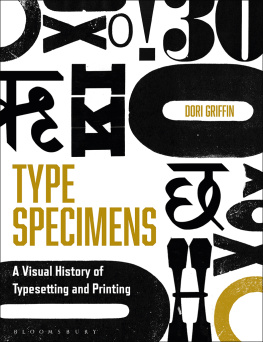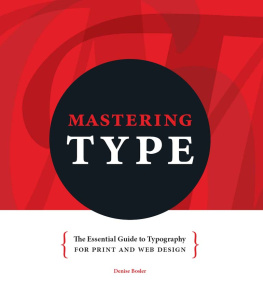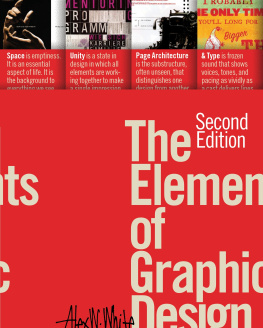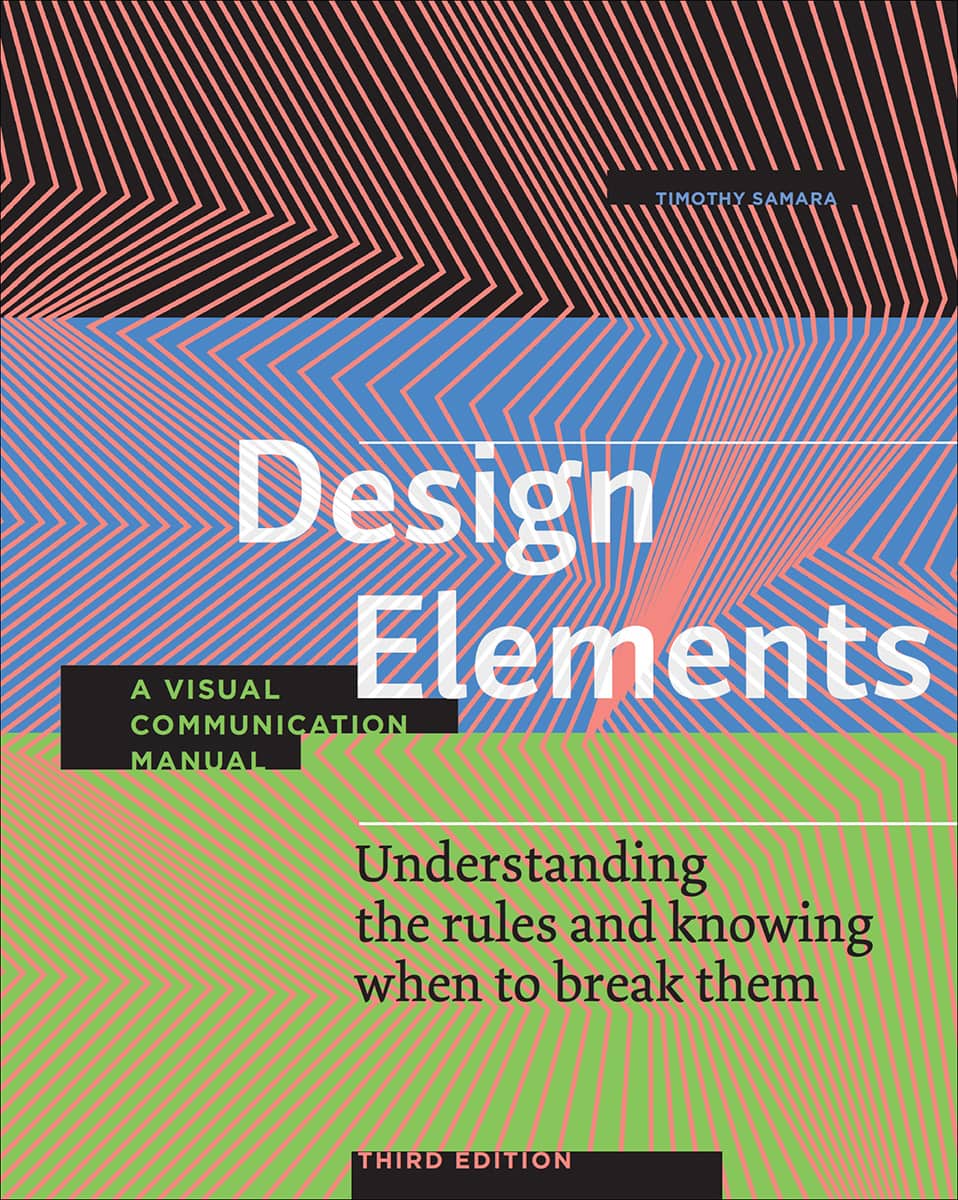Contents
Guide
Design Elements
A VISUAL COMMUNICATION MANUAL
Understanding the rules and knowing when to break them
TIMOTHY SAMARA
THIRD EDITION

2020 Quarto Publishing Group USA Inc.
s
Text Quarto Publishing Group USA Inc.
Images 2020 Credited Contributors
First published in 2020 by Rockport Publishers,
an imprint of The Quarto Group,
100 Cummings Center, Suite 265-D, Beverly, MA 01915, USA.
T (978) 282-9590 F (978) 283-2742 QuartoKnows.com
All rights reserved. No part of this book may be reproduced in any form without written permission of the copyright owners. All images in this book have been reproduced with the knowledge and prior consent of the artists concerned, and no responsibility is accepted by producer, publisher, or printer for any infringement of copyright or otherwise, arising from the contents of this publication. Every effort has been made to ensure that credits accurately comply with information supplied. We apologize for any inaccuracies that may have occurred and will resolve inaccurate or missing information in a subsequent reprinting of the book.
Rockport Publishers titles are also available at discount for retail, wholesale, promotional, and bulk purchase. For details, contact the Special Sales Manager by email at or by mail at The Quarto Group, Attn: Special Sales Manager, 100 Cummings Center, Suite 265-D, Beverly, MA 01915, USA.
Digital edition: 978-1-63159-873-9
Softcover edition: 978-1-63159-872-2
Digital edition published in 2020
Originally found under the following Library of Congress Cataloging-in-Publication Data
Samara, Timothy.
Design elements : a graphic style manual : understanding the rules and knowing when to break them / Timothy Samara.
p. cm.
ISBN-13: 978-1-59253-261-2 (flexibind)
ISBN-10: 1-59253-261-6 (flexibind)
1. Graphic design (Typography) 2. Layout (Printing) I. Title.
Z246 .S225
686.22dc22
2006019038
CIP
Design: Timothy Samara
Page Layout: Timothy Samara
What Is Graphic Design?
A graphic designer is a communicator: someone who takes ideas and gives them visual form so that others can understand them. The designer uses imagery, symbols, type, color, and materials (whether printed or on screen) to represent the ideas that must be conveyed; and to organize them into a unified experience that is intended to evoke a particular response.
While more or less confined to the creation of typefaces and books from the Middle Ages until the Industrial Revolution of the late 1700s and early 1800s, design expanded into advertising, periodicals, signage, posters, pamphlets, and ephemera with the appearance of a new consumer marketplace. The term graphic design itself appeared more recently (attributed to WA Dwiggins, an American illustrator and book designer, in 1922, to describe his particular activities). The formal study of design didnt come about until the 1920s, and the term entered into wide usage only after World War II.
In contrast to other disciplines in the visual arts, graphic designs purpose is typically defined by a clientits a service paid for by a company or other organizationrather than from within the designer. Although artistic creation historically had been commissioned by patrons, it wasnt until the 1830s that the mystique of the bohemian painter as expresser of self arose and, consequently, a marked distinction between fine and commercial art. Designers encouraged this distinction for philosophical, as well as strategic, reasons, especially as they began to seek recognition for design as a profession that could add tremendous value to corporate endeavors.
In the fifty-odd years since, the graphic designer has been touted as everything from visual strategist to cultural arbiter (and, since the late 1970s, as an author as well), shaping not only the corporate bottom line through clever visual manipulation of a brand-hungry public, but also the larger visual language of the contemporary environment. All these functions are important to graphic designbut, lest we forget the simplicity of the designers true nature, let us return to what a graphic designer does. A graphic designer assimilates verbal concepts and gives them form. This form-giving is a discipline that integrates an enormous amount of knowledge and skill with intuition, creatively applied in different ways as the designer confronts the variables of each new project.
A designer must understand semioticsthe processes and relationships inherent in perception and interpretation of meaning through visual and verbal material. He or she must have expertise in the flow of informationinstructional strategies, data representation, legibility, usability, cognitive ordering, and hierarchic problem solvingextending into typography, the mechanics of alphabet design, and reading. Designing requires analytical and technical mastery of image makinghow shapes, colors, and textures work to depict ideas, achieve aesthetic cohesion and dynamism, and signify higher-order concepts while evoking a strong emotional response. Further, a designer must be more than casually familiar with psychology and history, both with respect to cultural narratives, symbolism, and ritualized experiences, as well as to more commercial, consumer-based impulses and responses (what is often referred to as marketing). Last, but certainly not least, a designer must have great facility with (and often, in-depth, specialized knowledge of) multiple technologies needed to implement the designed solution: printing media and techniques, film and video, digital coding, industrial processes, architectural fabrication, and so on.
But graphic design is greater than just the various aspects that comprise it. Together, they establish a totality of tangible, and often intangible, experiences. A designer is responsible for the intellectual and emotional vitality of the experience he or she visits upon the audience, and his or her task is to elevate it above the banality of literal transmission or the confusing self-indulgent egoism of mere eye candy. And yet, beauty is a function, after all, of any relevant visual message. Just as prose can be dull or straightforward or well edited and lyrical, so too can a utilitarian object be designed to be more than just simply what it is. If function is important to the intellect, writes respected Swiss designer Willi Kunz, in his book, Typography: Macro- and Micro-Aesthetics, then form is important to the emotionsOur day-to-day life is enriched or degraded by our environment.
The focus of this book is on these formal, or visual, aspects of graphic design and, implicitly, their relevance for the messages to be created using them. Its a kind of user manual for creating what is understood to be strong design and empowering readers to effectivelyand skillfullyharness their creativity to meet the various challenges that designers encounter every day.
Graphic design is a complex combination of words and pictures, numbers and charts, photographs and illustrationsA popular art and a practical art, an applied art and an ancient art. Simply put, it is the art of visualizing ideas But it is also an idiomatic language, a language of cues and puns and symbols and allusions, of cultural references and perceptual inferences that challenge both the intellect and the eye.







